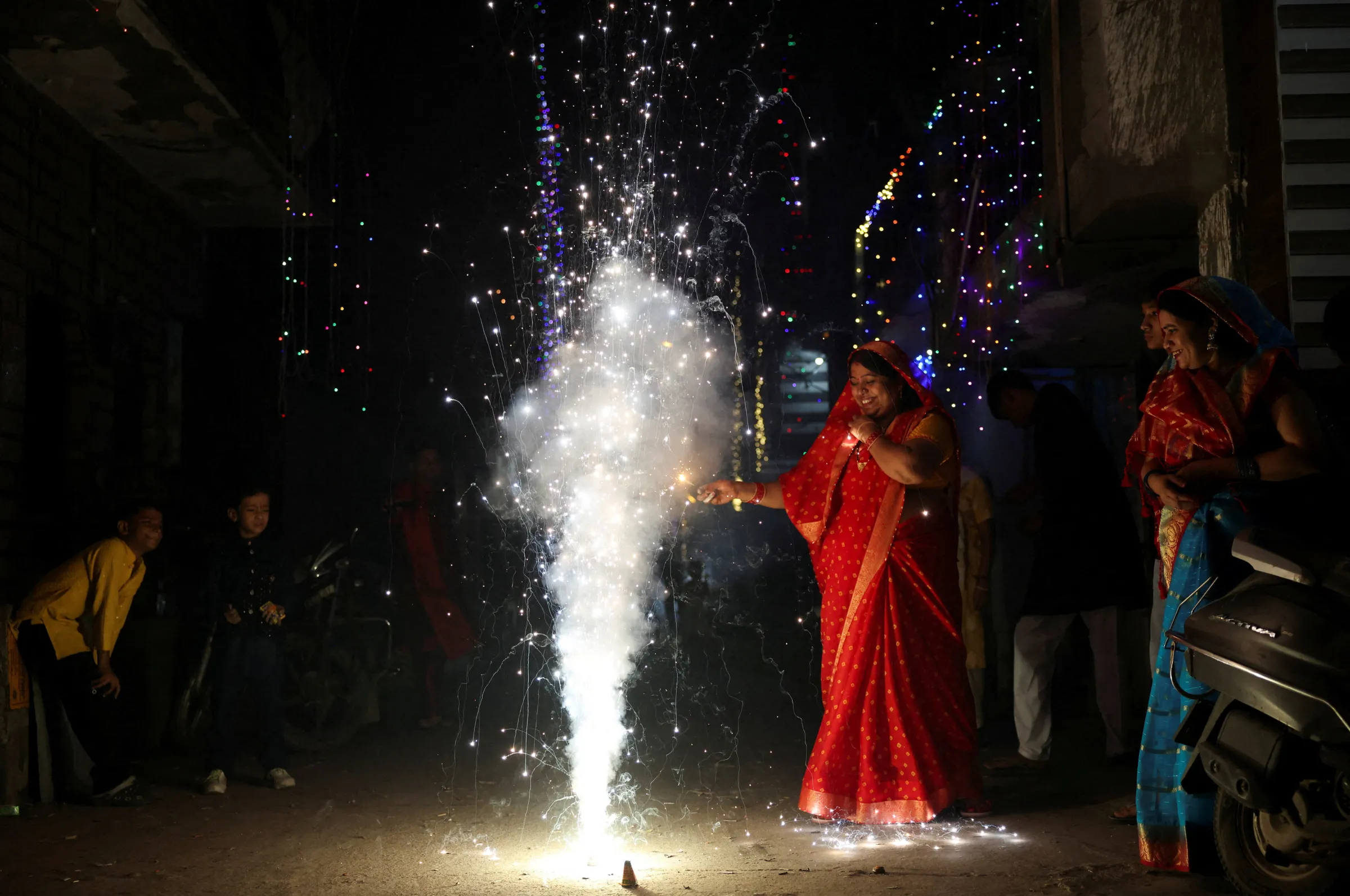Delhi looks to artificial rain to clear 'airpocalypse' smog

A woman lights fireworks to celebrate Diwali, the Hindu festival of lights, in New Delhi, India, October 20, 2025. REUTERS/Bhawika Chhabra
What’s the context?
Despite trials to induce rain, Delhi remained dry and engulfed in 'airpocalypse' smog
NEW DELHI - New Delhi failed in its attempts to trigger rain through cloud seeding this week after toxic smog engulfed the Indian capital in a so-called 'airpocalypse', partly due to the use of firecrackers during Diwali, the Hindu festival of lights.
Delhi Environment Minister Manjinder Singh Sirsa said on Tuesday two cloud seeding trials had been carried out in cooperation with the government's Indian Institute of Technology (IIT) in Kanpur city, which is spearheading the effort.
He said the city would witness scattered rainfall in the following hours. But there was none due to low moisture levels, according to IIT Kanpur.
"Rainfall could not be triggered yesterday because moisture levels were around 15 to 20%," the institute said in a statement on Wednesday, adding that cloud seeding plans for the day had been put on hold.
It said that data showed a reduction of pollution, indicating that "cloud seeding can contribute to improved air quality".
But Shahzad Gani, an assistant professor at IIT Delhi, said there was no evidence that cloud seeding that did not produce rain could improve air quality.
"Improvements in meteorology could have improved the air quality, such as stronger winds ... This is a classic case of correlation is not causation," he told Context.
He described the cloud seeding efforts as a "gimmick", urging long-term solutions such as reducing the sources of pollution and emissions.
The Swiss air-monitoring organisation IQAir classed Delhi's air as "unhealthy" on Wednesday, giving it a pollution score of 265, compared to 27 for London and 16 for New York.
Its PM2.5 reading for Delhi was nearly 38 times the World Health Organization's recommended levels. PM2.5 is particulate matter measuring 2.5 microns or less that can be carried into the lungs and cause deadly diseases and cardiac problems.
Here is what you need to know about cloud seeding:
What is cloud seeding?
Cloud seeding is a weather modification method that triggers rain. To seed a cloud, aircraft introduce a chemical agent, commonly silver iodide. It draws moisture to itself, allowing the cloud's water vapour to condense into droplets and produce rain, according to the World Meteorological Organization (WMO).
The process is not possible without clouds in the sky.
The idea of cloud seeding is to make rain form more efficiently inside clouds so more water comes down.
Gani said that when it is very polluted in Delhi, the atmosphere was extremely dry and stagnant, with stable winds - conditions that make it difficult for cloud seeding to trigger rain.
Why does Delhi need artificial rain?
Earlier this month, India's top court relaxed a ban on firecrackers in Delhi, permitting the use of so-called "green crackers" for a maximum of three hours each during Diwali on Oct. 19 and 20.
But revellers set off firecrackers far outside the allotted times, enveloping the city in a thick haze.
Delhi and its neighbouring districts are prone to a thick smog every winter as cold, heavy air traps construction dust, vehicle emissions and smoke from agricultural fires, leaving many of its 20 million residents struggling with respiratory illnesses.
In the past, authorities have closed schools, stopped some building work and placed restrictions on private vehicles to tackle the problem.
Why haven't authorities done cloud seeding before?
This isn't the first time Delhi authorities have announced cloud seeding plans to reduce smog. It was considered in 2023 and 2024, but weather conditions were unfavourable.
Sirsa had said there was not enough cloud cover immediately after Diwali to try cloud seeding, but later in the week, Delhi Chief Minister Rekha Gupta said a trial had been successful.
What other countries have tried cloud seeding before?
Cloud seeding was first trialled in the United States around World War Two and is now used in more than 50 countries, according to the WMO.
China has the biggest cloud-seeding operation, which it utilises not only to increase rainfall, but also to prevent hailstorms that can devastate crops.
In 2009, China's air force used artificial rain to clear Beijing's smog for a grand parade marking the 60th anniversary of Communist Party rule.
Beijing also turned to cloud seeding ahead of the 2008 Summer Olympics to try to ensure dry weather and clean air for its spectacular opening ceremony.
Does cloud seeding work?
While cloud seeding can have great benefits, especially in dry regions by improving water supply and thereby farm output and livelihoods, scientists say there are still many unknowns.
They say that although the amounts of silver iodide used for most cloud seeding are too small to hurt the environment or public health, the chemical can be toxic in very large quantities.
For example, in 2021, a plan to seed clouds over the mountains of New Mexico to increase snowfall was pulled after allegations it could poison people and the environment.
Cloud seeding could also lead to geo-political spats if over-used in one region, depriving areas downwind of rainfall.
The main stumbling block, however, is measuring cloud seeding's success.
Environmentalists say rainfall has increased by more than 10% in some areas where cloud seeding is used, but there could also be knock-on effects that are harder to quantify, such as increased river runoff.
This story was updated on October 29, 2025 at 15:00PM with the latest developments.
(Reporting by Annie Banerji; Editing by Jon Hemming.)
Context is powered by the Thomson Reuters Foundation Newsroom.
Our Standards: Thomson Reuters Trust Principles



















